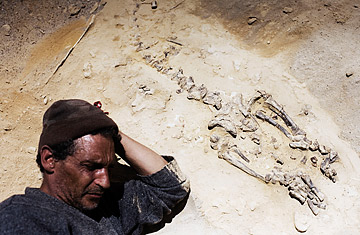
A researcher for Peru's Natural History Museum rests next to the fossilized skeleton of an ancient seal in the Ocucaje Desert in Ica, Peru.
(2 of 2)
But there is also a problem with control. Apolín, who is technically a biologist, is the only paleontological specialist in the ministry, and he is in the unit in charge of preventing theft and controlling items that are seized. In 2010, his first year on the job, police at the international airport in Lima seized 1,962 cultural items protected by law. Fossils accounted for 1,712 of the items seized.
Even if there were many more employees like Apolín, the law protecting cultural heritage is vague when it comes to fossils. "Fossils are in a kind of legal limbo in Peru. There are gaps in the law because there are people who do not want to include fossils as cultural heritage, because they have not been made by human hand," said Blanca Alva, director of the prevention office.
The ministry has an archaeological division, but there is no paleontology division. Paleontology falls to a unit of the Energy and Mines Ministry. Still, the Culture Ministry is getting ready in the next few weeks to declare Peru's first protected paleontological site. The area, known as the Inga Bridge, is a small site located just outside Lima. Apolín said it will be the first of its kind among 13,000 protected sites nationwide.
While Penny bristles with anger at fossil hunters digging through the desert to pull out what they can sell, he gets even more worked up about authorities, who he says have done nothing to stop it. He says their inaction makes them complicit. Penny gets madder still when he is lumped in with the fossil traffickers — Apolín points to video of Penny handling fossils — because of a small, bizarre collection, including shark teeth, in a single room he calls home in the old family mansion that has seen much better days. Under Peruvian law, the country's treasures, whether fossils or golden objects looted from tombs, can be held in personal collections. It is only illegal to remove them from the country.
"I have never sold a fossil, and what I have, I have found on the desert floor," he said. "There are amazing things out there, but if I tell anyone, they will be lost." Driving a specially equipped truck that lets him roam the desert, Penny is careful to cover his tracks. He continuously doubles back and drives in circles at times to throw others off his trail, fearful that fossil scavengers will follow him to his sacred spots.
Regional tourism authorities would like to promote the desert but worry that a flood of people could mean rampant destruction. "There is an entire desert with a massive amount of fossils. The desert is an attraction that we cannot promote, because large fossils are being taken away and no one is doing anything to stop it," said Elard Roca of the government's local tourism bureau.
Penny's solution is to declare the desert a protected area, but conservationists say the move would be impractical. Pedro Solano, who runs the conservation program for the Peruvian Environmental Law Society, one of the country's leading environmental groups, said that while there are important fossilized remains in the desert, "it would be wrong to say the entire area holds fossils and should be set aside. These kinds of generalization usually cause problems," he said.
Trying to guard the area is also nearly impossible because of its size. The area that contains fossil remains is about 180 miles long and 40 miles wide. The giant penguin was found in the northern reaches, while the whale skeletons are found from Ocucaje south. The Ocucaje stretch is about one-quarter of the total area. Solano said the goal for the desert "should not be to keep people out but manage the spaces for education and research to demonstrate its value as a resource." The Culture Ministry's Apolín said the best way to protect the area is "guaranteeing that fossils are not taken from the country. If we can improve control of fossils trafficking at the airport and ports, we would protect the site."
